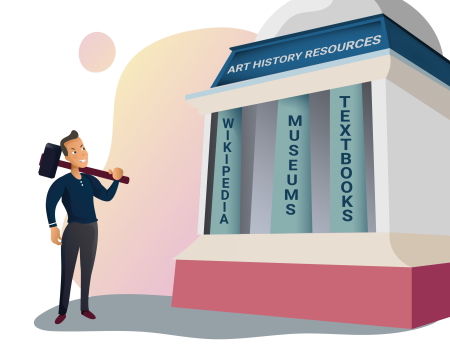About The Founder
At the Start
The year was 2000. I, Michael Zurakhinsky, had just finished college and had an offer for my first real job, in software engineering at a large New York firm. The job didn’t start for 2 weeks, and I spent every day during the interim at the Metropolitan Museum of Art. I didn’t have any formal art education, but I was drawn in by what I saw. It was exciting, overwhelming, and historic.
Fast forward to 2008. I still like art, and now I had more time to understand and discover. I tried to learn more: I read books, pored over wall plates, spent time on-line, and it was wonderul. But still, I couldn’t really understand how the history of art fit together. Was I doing something wrong? How does one grasp the significance and meaning behind the main works of art?
Further searching led me to understand that the art world is a club. A club ruled by institutions and high-powered PhDs that ultimately define what is important. And, I was pretty sure I wasn’t the only one on the outside trying to look in.
The (Broken) Pillars of Art History Education
Online, one of the best resources was Wikipedia. The idea behind Wikipedia is wonderful, but as an art history learning tool its’ value is limited. The site is a one-size-fits-all solution for every discipline. In addition, no two pages are alike, since different editors contribute content as they see fit. One artist may have 10 pages of detailed information, while another has a single paragraph. And the conceptual threads that tie together artists and movements just don’t exist.
I believe that the organization that should explain art history is the Museum of Modern Art in New York City (or similar top-notch museums). They have a phenomenal collection and enough talented PhDs to make a line from here to the moon. But it turns out that art education is not their priority. They only cover their own works of art, and they don’t touch upon the rest of art history. However, they do provide links to Wikipedia. (See above!!)
Art history books remained my only viable source of information. I do love to read and prefer to have a printed page in front of me rather than a screen full of text. Older textbooks are classics (and I do love a classic) but are terribly outdated. Try finding a female artist or an artist of color, not to mention anything about art history outside the Western canon! Newer, topic-based books are more inclusive, but they focus on a single subject. To understand how their particular artist or movement connects to others is a herculean task.
The Art Story: Born out of this challenge to the incumbents
I have to admit that I am highly impatient. When I want to learn something, I want to learn it quickly. And I want to be able to learn it wherever I am, including in my bathtub. No long-winded and technical books for me, please. Checking out large volumes at the library is for students writing their senior thesis, not for the other 99% of the world.
I suspected there would be a tremendous amount of time and effort involved in creating The Art Story non-profit and its’ website, but boy did I underestimate. But once the initiative was underway, I justified the incredible spend of time and money by the fact that I was personally learning about art as we attacked each new topic page.
The Early Years
One of the most gratifying experiences of the early days was the enthusiasm of our early recruits. The talented graduate students and art history professionals we hired were as excited as I was, and worked tirelessly to create quality content to make the site a reality. Meetings were held at local watering holes of Manhattan, and the site was finally launched in October of 2009.
Where We are Today
After 12 years with hundreds of writers on the job, we have accumulated the largest online encyclopedia of art in the world, with over 1000 topic pages. This is the equivalent of 9 copies of War and Peace. And we are adding new artists, movements, and ideas every week.
Not only have we created a vast resource covering major swaths of art history, we tie it together through timelines and definitions pages which are all carefully cross-referenced. And perhaps best of all, the material is well-organized, accessible, and consistent in both form and coverage. Read about your favorite artist right now on The Art Story, or dive into an art rabbit-hole of your choosing.
 Ask The Art Story AI
Ask The Art Story AI

